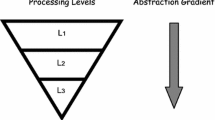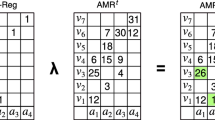Abstract
In this article we present a method that allows conditioning of the response of a linear distributed memory to a variable context. This method requires a system of two neural networks. The first net constructs the Kronecker product between the vector input and the vector context, and the second net supports a linear associative memory. This system is easily adaptable for different goals. We analyse here its capacity for the conditional extraction of features from a complex perceptual input, its capacity to perform quasi-logical operations (for instance, of the kind of “exclusive-or”), and its capacity to structurate a memory for temporal sequences which access is conditioned by the context. Finally, we evaluate the potential importance of the capacity to establish arbitrary contexts, for the evolution of biological cognitive systems.
Similar content being viewed by others
Literature
Anderson, J.A. 1970. “Two Models for Memory Organization Using Interacting Traces”.Math. Biosci.,8, 137–160.
— 1972. “A Simple Neural Network Generating an Interactive Memory”.Math. Biosci. 14, 197–220.
— 1983. “Cognitive and Psychological Computation with Neural Models”.IEEE Trans. Systems. Man Cybernetics 13, 799–815.
—, J. W. Silverstein, S. A. Ritz and R. S. Jones. 1977. “Distinctive Features, Categorical Perception, and Probability Learning: Some Applications of a Neural Model”.Psychol. Rev. 84, 413–451.
Ashby, W. R. 1958. “Requisite Variety and its Implications for the Control of Complex Systems”.Cybernetica 1, 83–99.
Bellman, R. 1960.Introduction to Matrix Analysis. New York: McGraw-Hill.
Changeux, J. P. and A. Danchin. 1976. “Selective Stabilization of Developing Synapses as a Mechanism for the Specification of Neuronal Networks”.Nature 264, 705–712.
Cooper, L. N. 1973. “A Possible Organization of Animal Memory and Learning.” In Proceedings of the Nobel Symposium on Collective Properties of Physical Systems, B. Lundquist and S. Lundquist (Eds) New York: Academic Press.
Kohonen, T. 1977.Associative Memory: A System Theoretical Approach. New York: Springer.
Monod, J. 1967. Leçon inaugurale, Collège de France.
— and F. Jacob. 1963. “Allosteric Proteins and Cellular Control Systems.”J. Molec. Biol. 6, 306–329.
Nass, M. M. and L. N. Cooper. 1975. “A Theory for the Development of Feature Detecting Cells in Visual Cortex”.Biol. Cybernetics 19, 1–18.
Ribchester, R. R. 1986.Molecule, Nerve and Embryo. Glasgow: Blackie.
Rumelhart, D. E., G. E. Hinton and J. L. McClelland. 1986. “A General Framework for Parallel Distributing Processing”. InParallel Distributing Processing, D. E. Rumelhart and J. L. McClelland (Eds). Massachusetts: MIT Press.
—— and R. J. Williams. 1986. “Learning Representations by Back-Propagating Errors”.Nature 323, 533–536.
Stone, G. O. 1986. “An Analysis of the Delta Rule and the Learning of Statistical Associations”. InParallel Distributing Processing, D. E. Rumelhart and J. L. McClelland (Eds). Massachusetts: MIT Press.
Author information
Authors and Affiliations
Additional information
Part of this study has been presented in a preliminary version at the XVI Reunión Científica de la Sociedad Argentina de Biofísica, Tigre, Argentina, December 1987.
Rights and permissions
About this article
Cite this article
Mizraji, E. Context-dependent associations in linear distributed memories. Bltn Mathcal Biology 51, 195–205 (1989). https://doi.org/10.1007/BF02458441
Received:
Issue Date:
DOI: https://doi.org/10.1007/BF02458441




